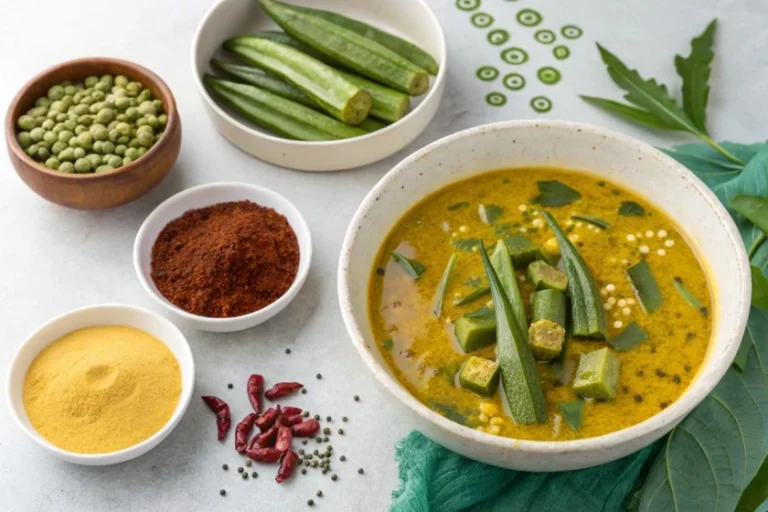Part 1: Introduction to Fresh Green Sundakkai Sambar Recipe
The Uniqueness of Fresh Green Sundakkai Sambar
Fresh Green Sundakkai Sambar Recipe is a culinary gem in South Indian kitchens. This delicious stew, bursting with the tanginess of tamarind and the bold bitterness of Sundakkai, provides a wholesome dining experience. It’s more than just a dish; it’s a celebration of traditional flavors that harmoniously blend with contemporary tastes.
Health and Cultural Value
Besides being a flavorful addition to any meal, Fresh Green Sundakkai Sambar Recipe is packed with health benefits. This dish, prepared with the unique Turkey berry (Sundakkai), is cherished not only for its medicinal properties but also for its ability to transform even the simplest meals into something both nutritious and hearty. When you serve Fresh Green Sundakkai Sambar, you’re not just offering a delicious dish—you’re sharing a recipe that’s deeply rooted in tradition and health-focused cooking.
Why You’ll Love It
Whether you’re a seasoned cook or a beginner in the kitchen, this recipe offers something exciting. From learning how to balance bitterness to creating the perfect spice blend, making this dish is as rewarding as eating it. Additionally, its adaptability ensures you can tweak it to your liking.
Part 2: Ingredients and Preparation
Essential Ingredients for Fresh Green Sundakkai Sambar
Fresh Green Sundakkai
The star ingredient, fresh green Sundakkai, must be carefully selected for the best results. Look for berries that are firm, vibrant, and free from blemishes. Before using, lightly crush them to remove seeds and reduce their natural bitterness. For added flavor, sauté them briefly in oil before mixing into the sambar.
Lentils (Toor Dal)
Toor dal, also called split pigeon peas, is indispensable for this recipe. It provides the creamy texture and subtle sweetness that balance the bold flavors of Sundakkai. Wash thoroughly and pressure cook until soft, ensuring a smooth base for your sambar.
Tamarind Pulp
Tamarind pulp infuses the dish with its signature tangy flavor. Soak a small ball of tamarind in warm water, mash, and strain the liquid. This step ensures the sambar has a zesty undertone that complements the bitterness of Turkey berries.
Spices and Seasonings
Sambar’s flavor profile is built upon aromatic spices. Use freshly ground sambar powder, turmeric, asafoetida, and curry leaves. Don’t forget mustard seeds and dried red chilies for tempering—they add a delightful aroma and depth.
Optional Vegetables
To enhance the richness, consider adding vegetables like tomatoes, onions, or drumsticks. These blend seamlessly with the Sundakkai and boost the overall flavor of the dish.
Preparation Steps
Cleaning and Prepping Sundakkai
Crush the Sundakkai gently to remove seeds, then rinse them under cold water. To reduce bitterness, sauté in a teaspoon of oil until they turn slightly golden.
Cooking the Lentils
Pressure cook ½ cup of toor dal with a pinch of turmeric and adequate water until soft and mushy. Mash the lentils to a smooth consistency and set aside.
Making Tamarind Extract
Soak tamarind (the size of a small lemon) in half a cup of warm water for 15 minutes. Squeeze and strain the liquid, discarding the pulp.
Sautéing Spices and Vegetables
Heat oil in a pan, add mustard seeds, and let them splutter. Toss in dried red chilies, curry leaves, and a pinch of asafoetida. Next, sauté chopped onions and tomatoes (if using) until soft.
Combining Ingredients
Add the prepared Sundakkai to the sautéed mixture. Pour in the tamarind extract, then let it simmer for a few minutes. Stir in the mashed lentils, sambar powder, and enough water to achieve the desired consistency.
Simmering to Perfection
Cook the mixture on medium heat for 10–15 minutes, allowing the flavors to meld together. Adjust salt and spice levels to taste. The final result should be a rich, aromatic sambar with a balanced flavor profile.
Part 3: Serving Suggestions and Variations
Serving Fresh Green Sundakkai Sambar
With Steamed Rice
The most traditional way to enjoy Fresh Green Sundakkai Sambar is with a plate of hot, fluffy steamed rice. Serve it with crispy papad or fried appalams to add texture to the meal. A drizzle of ghee over the sambar-laden rice enhances its flavor immensely.
With Idli or Dosa
Sundakkai sambar is not just limited to rice. It pairs beautifully with soft idlis or golden, crispy dosas. The tangy, slightly bitter sambar complements the mild flavors of these breakfast staples, making it a delightful morning or evening meal option.
As a Soup
For a lighter option, serve Sundakkai sambar as a standalone soup. Its bold flavors and wholesome ingredients make it a comforting choice, especially on cooler days or when you’re craving something warming yet nutritious.
Variations of Sundakkai Sambar
Using Different Lentils
While toor dal is the go-to for sambar, you can experiment with alternatives. Moong dal adds a subtle sweetness, whereas masoor dal brings a slightly earthy flavor. Each lentil variation offers a unique twist on the traditional recipe.
Incorporating Additional Vegetables
Elevate the nutritional value and flavor profile by adding vegetables like drumsticks, carrots, or even brinjal (eggplant). These additions complement the tanginess of tamarind and the bitterness of Sundakkai, creating a more robust dish.
Adjusting Spice Levels
Sambar’s beauty lies in its adaptability. If you prefer a spicier dish, increase the quantity of red chilies in the tempering or add a touch of freshly ground black pepper. For milder palates, reduce the heat while ensuring that the tamarind and Sundakkai flavors remain prominent.
Part 4: Health Benefits and Cultural Significance
Health Benefits of Sundakkai
Medicinal Properties
Turkey berry (Sundakkai) is more than just a flavorful addition to sambar—it’s a natural healer. In traditional South Indian medicine, it’s often used to combat digestive disorders, reduce intestinal infections, and alleviate stomach ulcers. Its anti-inflammatory and antibacterial properties make it an essential ingredient in many Ayurvedic remedies. Moreover, consuming Sundakkai regularly is believed to enhance immunity and fight fatigue.
Nutritional Profile
Packed with iron, potassium, calcium, and fiber, Sundakkai is a powerhouse of nutrients. It contains antioxidants that neutralize harmful free radicals, promoting better skin and overall health. Additionally, it’s low in calories, making it a perfect choice for those looking to maintain a balanced diet.
For more insights into the health benefits of Turkey berry, refer to Health Benefits of Turkey Berry.
Nutritional Content of Fresh Green Sundakkai Sambar (Per 100g)
Understanding the nutritional value of Fresh Green Sundakkai Sambar highlights its role as a healthy and wholesome dish. Packed with protein, fiber, and essential vitamins, this dish is a perfect addition to a balanced diet.
| Nutrient | Amount (Per 100g) |
|---|---|
| Calories | 95 kcal |
| Protein | 5.2 g |
| Carbohydrates | 14.5 g |
| Fiber | 3.8 g |
| Fat | 2.5 g |
| Vitamin C | 8 mg |
| Iron | 1.2 mg |
| Calcium | 40 mg |
| Potassium | 240 mg |
| Magnesium | 22 mg |
Cultural Importance of Sambar in South India
Festivals and Traditions
Sambar, especially Fresh Green Sundakkai Sambar, holds a sacred place in South Indian households, particularly during festivals and religious ceremonies. This flavorful dish is often prepared as part of the festive spread, served alongside rice, payasam, and an assortment of side dishes. The preparation and sharing of Fresh Green Sundakkai Sambar during such events not only symbolize abundance and unity but also reflect the region’s rich culinary heritage deeply rooted in tradition.
Regional Variations
South India’s culinary diversity is beautifully reflected in the many regional variations of sambar. Tamil Nadu’s version emphasizes the use of freshly ground sambar powder, while Karnataka’s huli includes a hint of jaggery for a subtle sweetness. Kerala’s sambar often features coconut, and Andhra Pradesh leans towards spicier profiles. Each state, albeit unique in preparation, preserves the essence of this iconic dish.
Part 5: Frequently Asked Questions (FAQs)
FAQs About Fresh Green Sundakkai Sambar
How do you remove bitterness from Sundakkai?
To reduce the bitterness of Sundakkai, lightly crush the berries to remove the seeds, as they contain the most bitterness. Sautéing the berries in a small amount of oil before adding them to the dish further mellows their flavor.
How do you use Sundakkai?
Turkey berry (Sundakkai) is versatile and can be used in a variety of dishes, including sambar, kuzhambu, and stir-fries. It’s commonly sautéed with spices or cooked with tamarind to balance its bitterness.
What is Sundakkai, and where can I find it?
Sundakkai, also known as Turkey berry, is a small green fruit native to South Asia. It is typically available in Indian grocery stores or specialty markets, either fresh or dried.
Can I use dried Sundakkai instead of fresh ones?
Yes, dried Sundakkai is a viable alternative to fresh berries. Soak them in warm water for 15–20 minutes to rehydrate before cooking. Dried Sundakkai tends to have a more concentrated flavor.
How do I reduce the bitterness of Sundakkai in the sambar?
In addition to sautéing the berries, cooking them in tamarind extract helps balance their bitterness. You can also pair them with vegetables like tomatoes or carrots for a sweeter undertone.
Is it possible to make Sundakkai sambar without tamarind?
Certainly! While tamarind provides the classic tang, you can substitute it with raw mango, lemon juice, or tomato puree for a different flavor profile. Adjust the quantity based on your taste preference.
What are some common side dishes served with Sundakkai sambar?
Sundakkai sambar pairs wonderfully with crispy papads, coconut chutney, or a simple vegetable stir-fry. Pickles and fried appalams also complement the dish, especially when served with rice.
How do I store leftover Sundakkai sambar, and how long does it last?
Store leftover sambar in an airtight container and refrigerate it. It can last up to 3 days when properly stored. Reheat it thoroughly before serving, and add a splash of water if the consistency becomes too thick.
Conclusion
Fresh Green Sundakkai Sambar is not just a dish; it’s a celebration of South Indian culinary traditions and the perfect harmony of flavors. The tanginess of tamarind, the earthy richness of lentils, the bold bitterness of Sundakkai, and the medley of aromatic spices come together to create a dish that is wholesome, satisfying, and deeply nourishing.
Beyond its exceptional taste, this sambar offers a plethora of health benefits, from aiding digestion to boosting immunity. Its adaptability also makes it an ideal recipe for experimentation—whether you’re substituting lentils, adding your favorite vegetables, or adjusting the spice levels to suit your palate.
The cultural importance of sambar in South India cannot be overstated. It graces festive tables, daily meals, and even special gatherings with its timeless appeal. Whether you’re enjoying it with a steaming bowl of rice, dipping fluffy idlis into its flavorful depths, or savoring it as a warming soup, Sundakkai sambar always leaves an impression of comfort and tradition.
Cooking Fresh Green Sundakkai Sambar is also an opportunity to connect with the essence of South Indian cooking. The process—be it grinding fresh spices, carefully balancing flavors, or simmering ingredients to perfection—demands mindfulness and care, resulting in a dish that satisfies the soul as much as the stomach.
So why wait? Gather the ingredients, set aside some time, and indulge in the magic of preparing this iconic dish. Whether you’re a seasoned chef or a beginner, this recipe is sure to delight and inspire. And as you share it with family and friends, you’ll discover why Fresh Green Sundakkai Sambar is a cherished treasure in the world of Indian cuisine.
Happy cooking and enjoy the symphony of flavors that only a well-made sambar can offer!

